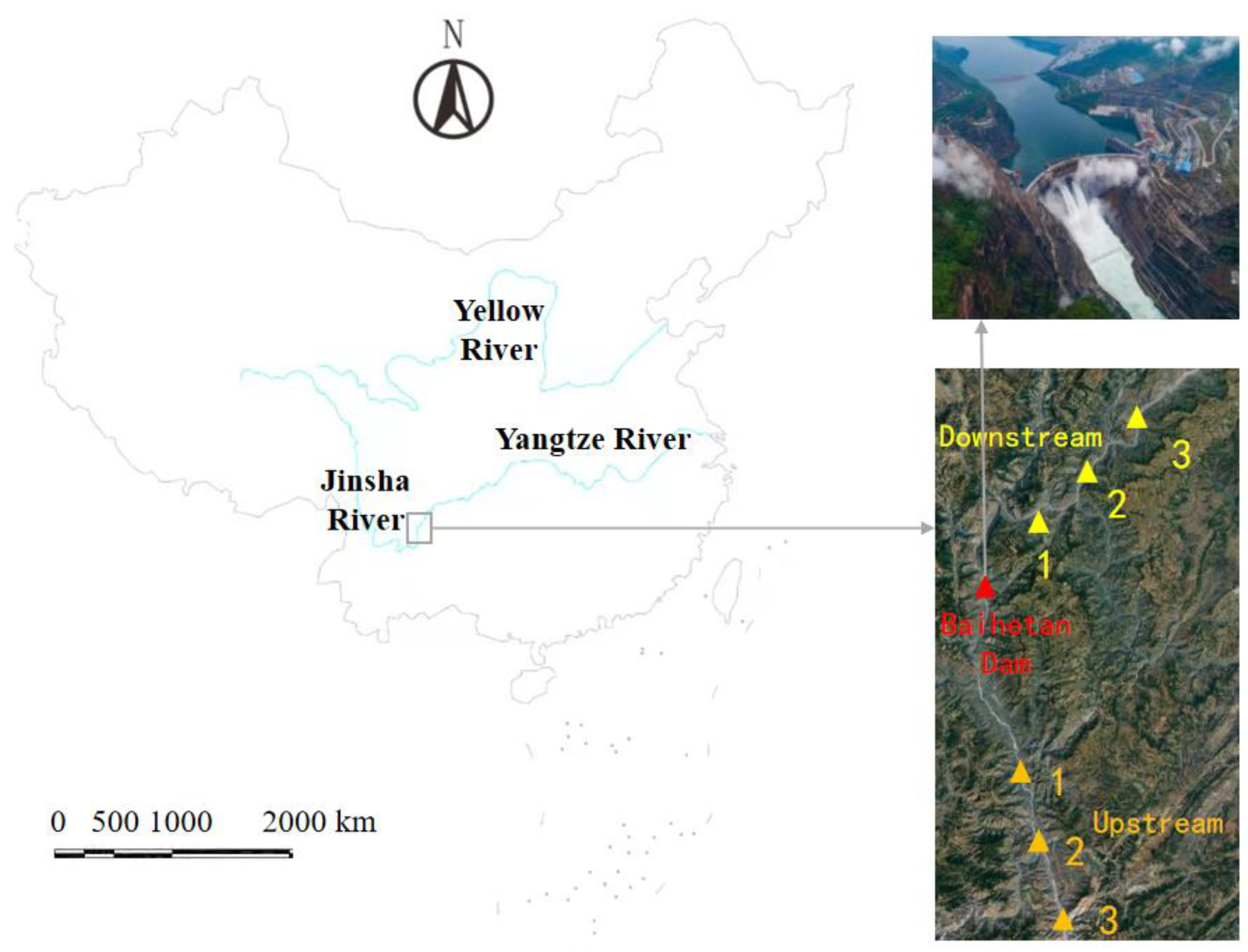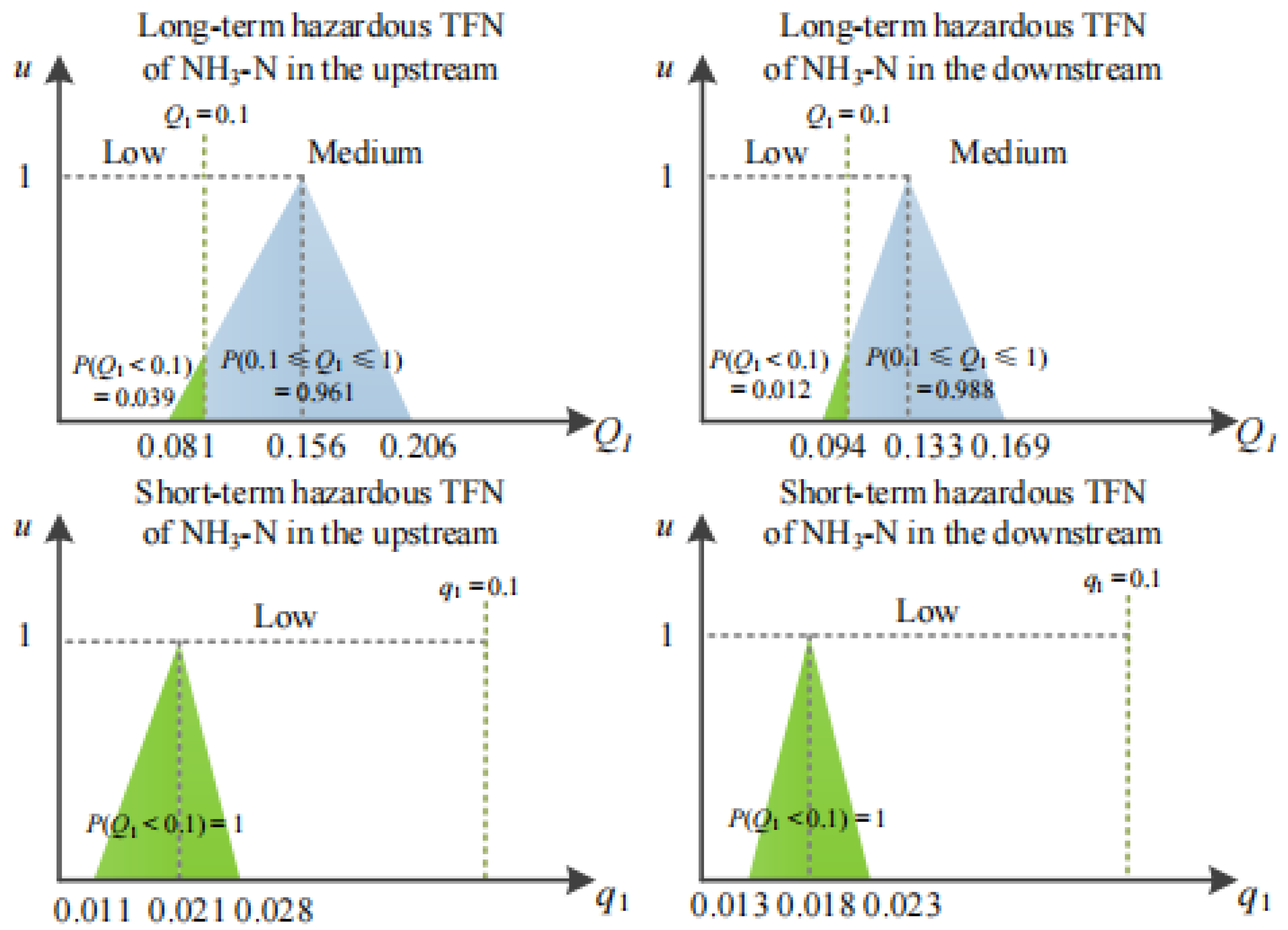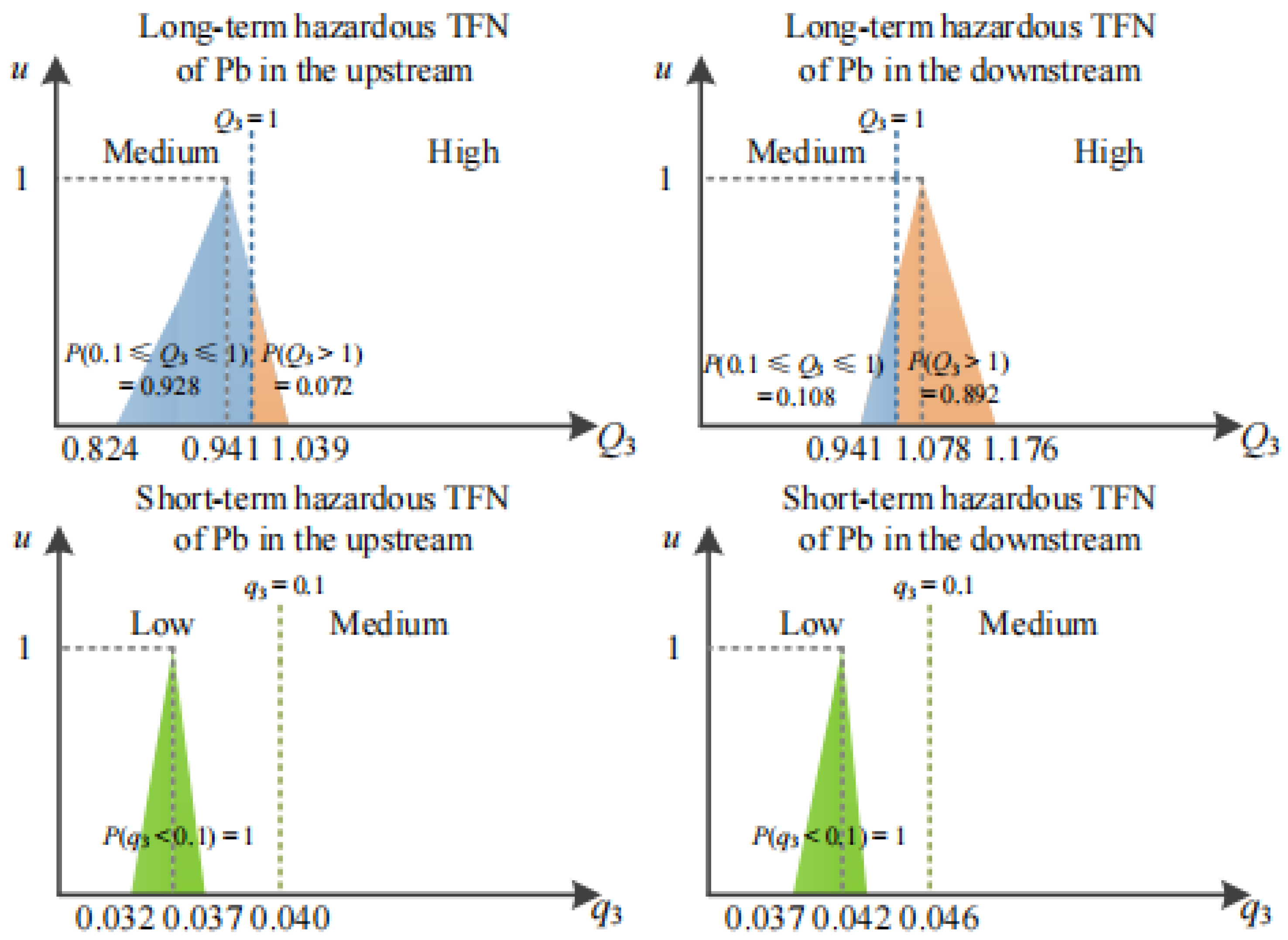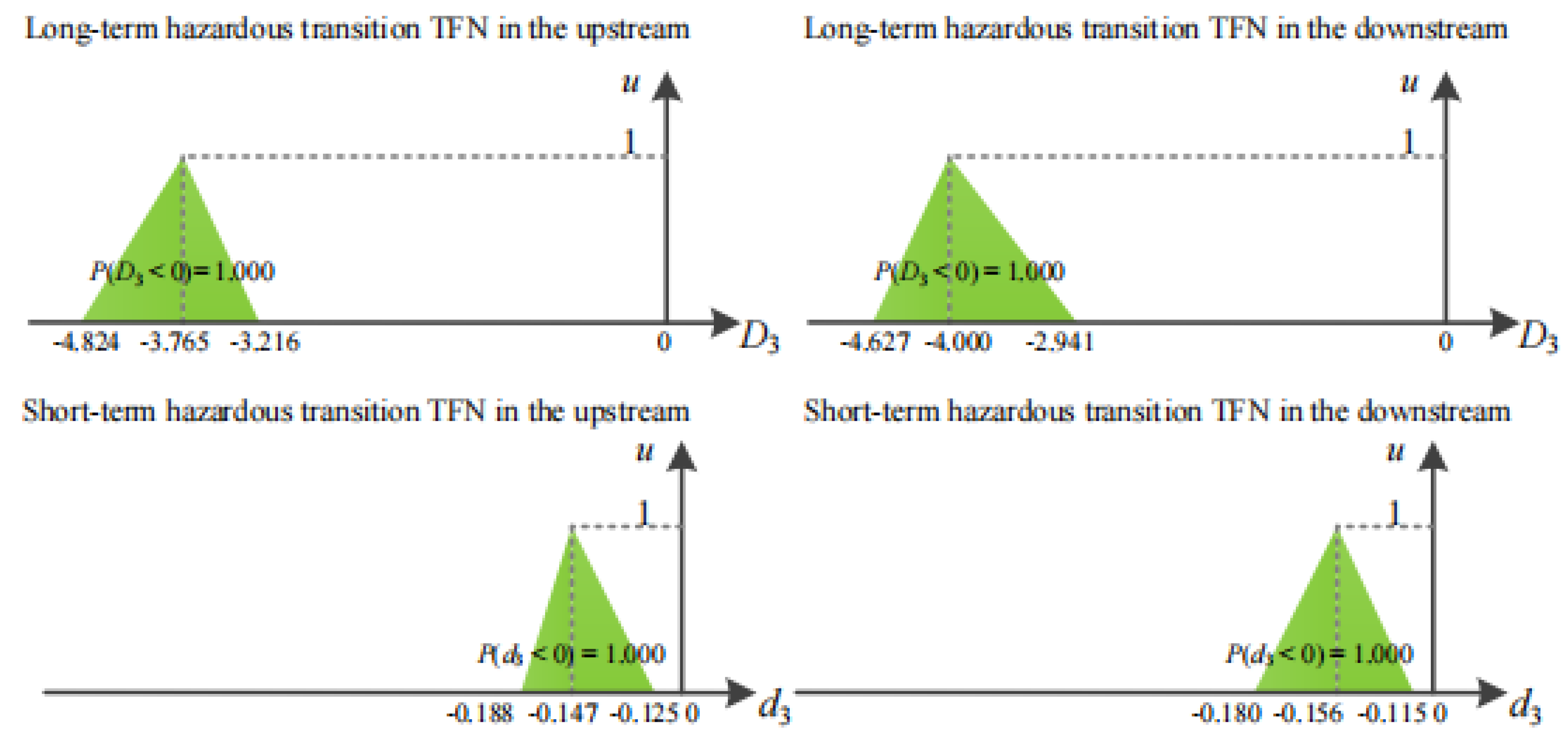Ecological Risk Evaluation of Baihetan Dam Based on Fuzzy Hazard Quotient Model
Abstract
:1. Introduction
2. Methods and Materials
2.1. Study Area
- (i)
- The representative pollutants should have definite biological safety thresholds.
- (ii)
- The representative pollutants should have the potential to exceed their biological safety threshold.
2.2. HQ Model
- (i)
- The concentration distribution of pollutants in the water is usually uneven because the dam construction changes the hydrodynamic conditions [6]. As a result, the exposure concentration in Equations (1) and (2) is not a unique value but has uncertainty.
- (ii)
- As the dams are usually far from urban areas, the environmental monitoring data are not abundant [6]. For example, due to inconvenient transportation, only two investigations were made for this paper, which reflect the environmental conditions before and after the construction of Baihetan Dam. Therefore, using conventional mathematical statistics, time series analysis, or machine learning methods to evaluate the changing patterns of HQ values induced by dam construction is difficult.
2.3. TFN Theory
- (1)
- (2)
2.4. Fuzzy HQ Model
2.4.1. Hazardous TFN Model
2.4.2. Transition TFN Model
3. Results and Discussion
3.1. Concentrations of Pollutants
- (i)
- The construction of Baihetan Dam changed the hydraulic conditions of the Jinsha River.
- (ii)
- The pollution sources in the basin changed.
3.2. Ecological Risk Assessment
3.3. Influence of Baihetan Dam on Ecological Risk
3.4. Comparisons between Traditional HQ and Fuzzy HQ
- (i)
- The traditional HQ model can produce an approximate range of HQs. The range of values obtained by fuzzy HQ is consistent with that of conventional HQ, which indicates that the fuzzy HQ model is plausible and valid. On this basis, the fuzzy HQ model is designed based on TFN theory and can further quantify the possibility of ecological risk belonging to each grade, which comprehensively and accurately reflects the uncertainties of the concentration distribution of pollutants in the water.
- (ii)
- When the range of HQs is not a subset of the judgment interval, the traditional HQ is almost unable to identify the ecological hazard grade. Table 2 shows that the range of long-term HQ of Cu in the upstream locations before dam construction was [0.830, 1.404], which crossed two judgment intervals, medium (0.1–1), and high (>1). The conventional HQ cannot calculate the probability of the long-term HQ falling into the two judgment intervals; therefore, it cannot identify the ecological hazard grade. Nevertheless, the fuzzy HQ model solves this problem by introducing hazardous vectors.
- (iii)
- Traditional HQ cannot accurately reflect the changes in ecological risks before and after dam construction. The fuzzy HQ model includes a hazardous TFN model and a transitional TFN model. The transition TFN model is specifically used to evaluate the ecological risk variation induced by dam construction. For example, Table 3 shows that the chronic ecological risk of Cu upstream and downstream was mainly high grade before the dam construction and completely medium grade afterwards. The chronic ecological risk of Cu had a variation in grades with a considerable downward trend after the construction of Baihetan Dam.
4. Conclusions
Supplementary Materials
Author Contributions
Funding
Data Availability Statement
Conflicts of Interest
References
- Sun, J.; Zhang, T.; Zhu, D.Z.; Fu, J. Simulative evaluation of fish habitat of backwater tributary of Baihetan Reservoir. Water Resour. Hydropower Eng. 2013, 44, 17–22. [Google Scholar]
- Yang, R.; Shang, P.; Yu, D. Water environment and atmospheric environment control of Baihetan Hydropower Station Project. Water Resour. Hydropower Eng. 2015, 46, 60–61, 64. [Google Scholar]
- Agostinho, A.A.; Gomes, L.C.; Veríssimo, S.; Okada, E.K. Flood regime, dam regulation and fish in the Upper Paraná River: Effects on assemblage attributes, reproduction and recruitment. Rev. Fish Biol. Fish. 2004, 14, 11–19. [Google Scholar] [CrossRef]
- Yang, T.; Zhang, Q.; Chen, Y.D.; Tao, X.; Xu, C.Y.; Chen, X. A spatial assessment of hydrologic alteration caused by dam construction in the middle and lower Yellow River, China. Hydrol. Processes Int. J. 2008, 22, 3829–3843. [Google Scholar] [CrossRef]
- Graf, W.L. Downstream hydrologic and geomorphic effects of large dams on American rivers. Geomorphology 2006, 79, 336–360. [Google Scholar] [CrossRef]
- Lu, J.; Wang, S.; Li, Y.; Yan, F. Ecological risk assessment of ammonia nitrogen in rare fish reserve in the upper reaches of the Yangtze River. Water Resour. Power 2022, 40, 53–56. [Google Scholar]
- Liang, F.; Yang, S.; Sun, C. Primary health risk analysis of metals in surface water of Taihu Lake, China. Bull. Environ. Contam. Toxicol. 2011, 87, 404–408. [Google Scholar] [CrossRef]
- Feng, J.; Hu, P.; Li, X.; Liu, S.; Sun, J. Ecological and health risk assessment of polycyclic aromatic hydrocarbons (PAHs) in surface water from middle and lower reaches of the Yellow River. Polycycl. Aromat. Compd. 2016, 36, 656–670. [Google Scholar] [CrossRef]
- Ding, T.T.; Du, S.L.; Huang, Z.Y.; Wang, Z.J.; Zhang, J.; Zhang, Y.H.; Liu, S.S.; He, L.S. Water quality criteria and ecological risk assessment for ammonia in the Shaying River Basin, China. Ecotoxicol. Environ. Saf. 2021, 215, 112141. [Google Scholar] [CrossRef]
- Official Website of China. Three Gorges Corporation. Available online: www.ctg.com.cn (accessed on 27 July 2021).
- Yan, Z.; Meng, W.; Liu, Z.; Yu, R. Development of Freshwater Aquatic Life Criteria for Ammonia in China. Environ. Sci. 2011, 32, 1564–1570. [Google Scholar]
- Wu, F.; Feng, C.; Cao, Y.; Zhang, R.; Li, H.; Zhao, X. Aquatic Life Ambient Freshwater Quality Criteria for Copper in China. Asian J. Ecotoxicol. 2011, 6, 617–628. [Google Scholar]
- He, L.; Cai, J.; Gao, F.; Wang, X.; Wang, W.; Yan, Z.; Zhou, J.; Liu, Z. Studies of Freshwater Aquatic Life Water Ambient Quality Criteria for Lead and Their Tentative Application to Risk Assessment. Environ. Sci. Technol. 2014, 37, 31–37+95. [Google Scholar]
- GB-3838-2002; National Surface Water Environmental Quality Standards of China. Chinese Environmental Protection Agency, Chinese General Administration of Quality Supervision, Inspection and Quarantine, China Standards Press: Beijing, China, 2002.
- Wang, Y.; Yan, Z.; Zheng, X.; Zhao, Y.; Zhang, Y.; Yang, N. Preliminary aquatic life criteria development and ecological risk assessment of ammonia in seven major river basins in China. Mar. Sci. Bull. 2016, 18, 55–68. [Google Scholar]
- Ma, L.; Liu, L.; Song, L.; Wang, L. Risk analysis of water quality of Wangyu River during water diversion. J. Hohai Univ. (Nat. Sci.) 2014, 42, 13–18. [Google Scholar]
- Li, L.; Song, F.; Liu, G.; Yan, F. Evaluation of grey water footprint of Hubei Province based on triangular fuzzy number theory. Water Resour. Power 2022, 40, 49–52. [Google Scholar]
- Li, D.; Lu, X.X.; Yang, X.; Chen, L.; Lin, L. Sediment load responses to climate variation and cascade reservoirs in the Yangtze River: A case study of the Jinsha River. Geomorphology 2018, 322, 41–52. [Google Scholar] [CrossRef]
- Zhang, X.B.; Wen, A.B. Variations of sediment in upper stream of Yangtze River and its tributary. J. Hydraul. Eng. 2002, 4, 56–59. [Google Scholar]
- Yang, Z.; Zhang, P.; Tang, H.; Gong, Y.; Dong, C.; Chen, X.; Zhao, N. The formation of habitat suitability curves for Coreius guichenoti (Sauvage & Dabry de Thiersant, 1874) of the lower Jinsha River. Ecol. Sci. 2017, 36, 129–137. [Google Scholar]
- Feng, Y.; Bao, Q.; Xiao, X.; Lin, M. Geo-accumulation vector model for evaluating the heavy metal pollution in the sediments of Western Dongting Lake. J. Hydrol. 2019, 573, 40–48. [Google Scholar] [CrossRef]
- Feng, Y.; Chenglin, L.; Bowen, W. Evaluation of heavy metal pollution in the sediment of Poyang Lake based on stochastic geo-accumulation model (SGM). Sci. Total Environ. 2019, 659, 1–6. [Google Scholar] [CrossRef]
- Zhang, X. Status and Causes of Sediment Change in the Upper Yangtze River and Sediment Reduction Measures—Comparison of Jialing River with Jinsha River. Soil Water Conserv. China 1999, 2, 24–26, 48. [Google Scholar]
- Zhu, L.; Xu, Q.; Dong, B.; Qin, L. Study on the effect and influencing factors of sand discharge of Xiluodu Reservoir in the Lower Jinsha River. Adv. Water Sci. 2021, 32, 544–555. [Google Scholar]
- Fan, Q.; Wang, Z.; Wu, G. The important role of the construction of Baihetan Hydropower Station in Jinsha River. Water Power 2018, 44, 1–6, 12. [Google Scholar]
- Liu, W.; Xu, S.; Yang, J.; Wu, W.; Lu, X.; Yin, H. Mineralogical characteristics of suspended matters and sediments in the Jinshajiang River and their superficial geochemical significance. Bull. Mineral. Petrol. Geochem. 2007, 2, 164–169. [Google Scholar]
- Wang, X.; Dong, Z.; Wang, W.; Luo, Y.; Tan, Y. Stochastic grey water footprint model based on uncertainty analysis theory. Ecol. Indic. 2021, 124, 107444. [Google Scholar] [CrossRef]
- Yunnan Provincial Bureau of Statistics. Statistics Yearbook of Yunan Province; China Statistics Press: Beijing, China, 2020. [Google Scholar]
- Wang, R.; Ma, G.; Fang, Z. Safety assessment and acute toxicity of copper‚ cadmium and zinc to white clound mountain minnow Tanichthys albonubes. Fish. Sci. 2006, 25, 117–120. [Google Scholar]
- Wang, F.; Liao, J.; Mao, D.; Sun, C.; Yang, S.; Zhou, J.; Liu, H.; Gao, S.; Li, M. Aquatic quality criteria and ecological risk assessment for lead in typical waters of China. Asian J. Ecotoxicol. 2017, 12, 434–445. [Google Scholar]














| Pollutant | Short-Term Criteria | Long-Term Criteria |
|---|---|---|
| NH3-N | 1.1800 mg/L | 0.1600 mg/L |
| Cu | 0.0300 mg/L | 0.0094 mg/L |
| Pb | 0.1310 mg/L | 0.0051 mg/L |
| Evaluation Items | Upstream | Downstream | |
|---|---|---|---|
| Ecological risk before dam construction | Long-term HQ | [0.830, 1.404] | [0.766, 1.362] |
| Grade | / | / | |
| Ecological risk after dam construction | Long-term HQ | [0.585, 0.872] | [0.638, 0.883] |
| Grade | Medium | Medium | |
| Changes in ecological risk | / | / | |
| Evaluation Items | Upstream | Downstream | |
|---|---|---|---|
| Ecological risk before dam construction | Long-term HQ | {0.830, 1.106, 1.404} | {0.766, 1.096, 1.362} |
| Grade | High | High | |
| Hazardous vectors | {0.000, 0.182, 0.818} | {0.000, 0.278, 0.772} | |
| Ecological risk after dam construction | Long-term HQ | {0.585, 0.713, 0.872} | {0.638, 0.745, 0.883} |
| Grade | Medium | Medium | |
| Hazardous vectors | {0.000, 1.000, 0.000} | {0.000, 1.000, 0.000} | |
| Changes in ecological risk | Transition TFN | {−0.819, −0.394, 0.043} | {−0.723, −0.351, 0.017} |
| Probability of risk decreasing | 0.995 | 0.965 | |
| Probability of risk increasing | 0.005 | 0.035 | |
Publisher’s Note: MDPI stays neutral with regard to jurisdictional claims in published maps and institutional affiliations. |
© 2022 by the authors. Licensee MDPI, Basel, Switzerland. This article is an open access article distributed under the terms and conditions of the Creative Commons Attribution (CC BY) license (https://creativecommons.org/licenses/by/4.0/).
Share and Cite
Yan, F.; Li, N.; Yang, Z.; Qian, B. Ecological Risk Evaluation of Baihetan Dam Based on Fuzzy Hazard Quotient Model. Water 2022, 14, 2694. https://doi.org/10.3390/w14172694
Yan F, Li N, Yang Z, Qian B. Ecological Risk Evaluation of Baihetan Dam Based on Fuzzy Hazard Quotient Model. Water. 2022; 14(17):2694. https://doi.org/10.3390/w14172694
Chicago/Turabian StyleYan, Feng, Na Li, Zhigang Yang, and Bao Qian. 2022. "Ecological Risk Evaluation of Baihetan Dam Based on Fuzzy Hazard Quotient Model" Water 14, no. 17: 2694. https://doi.org/10.3390/w14172694
APA StyleYan, F., Li, N., Yang, Z., & Qian, B. (2022). Ecological Risk Evaluation of Baihetan Dam Based on Fuzzy Hazard Quotient Model. Water, 14(17), 2694. https://doi.org/10.3390/w14172694






